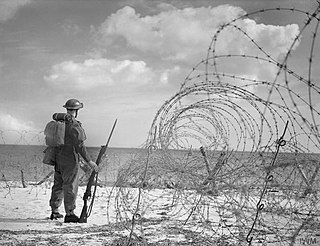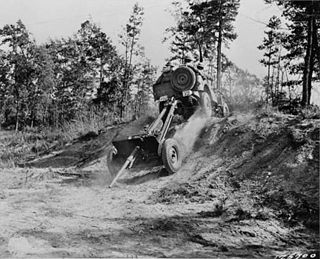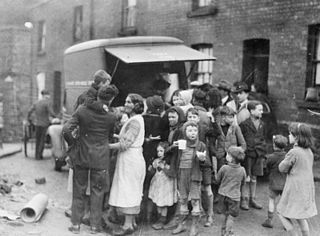 W
WThe Allied military phonetic spelling alphabets prescribed the words that are used to represent each letter of the alphabet, when spelling other words out loud, letter-by-letter, and how the spelling words should be pronounced for use by the Allies of World War II. They are not a "phonetic alphabet" in the sense in which that term is used in phonetics, i.e. they are not a system for transcribing speech sounds.
 W
WThe Belfast Blitz consisted of four German air raids on strategic targets in the city of Belfast in Northern Ireland, in April and May 1941 during World War II, causing high casualties. The first was on the night of 7–8 April 1941, a small attack which probably took place only to test Belfast's defences. The next took place on Easter Tuesday, 15 April 1941. 200 Luftwaffe bombers attacked military and manufacturing targets in the city of Belfast. Some 900 people died as a result of the bombing and 1,500 were injured. High explosive bombs predominated in this raid. Apart from those on London, this was the greatest loss of life in any night raid during the Blitz.
 W
WThe Blitz was a German bombing campaign against the United Kingdom in 1940 and 1941, during the Second World War. The term was first used by the British press and originated from the term Blitzkrieg, the German word for 'lightning war'.
 W
WBritish anti-invasion preparations of the Second World War entailed a large-scale division of military and civilian mobilisation in response to the threat of invasion by German armed forces in 1940 and 1941. The British Army needed to recover from the defeat of the British Expeditionary Force in France, and 1.5 million men were enrolled as part-time soldiers in the Home Guard. The rapid construction of field fortifications transformed much of the United Kingdom, especially southern England, into a prepared battlefield. Sea Lion was never taken beyond the preliminary assembly of forces. Today, little remains of Britain's anti-invasion preparations; only reinforced concrete structures such as pillboxes and anti-tank cubes are commonly found.
 W
WThe Philippines campaign, also known as the Battle of the Philippines or the Fall of the Philippines, was from December 8, 1941, to May 8, 1942, the invasion of the Philippines by the Empire of Japan and the defense of the islands by United States and the Philippine Armies during World War II.
 W
WThe Carolina Maneuvers were a series of United States Army exercises held around Southern North Carolina and Northern South Carolina in 1941. The exercises, which involved some 350,000 troops, was designed to evaluate United States training, logistics, doctrine, and commanders.
 W
WThe declaration of war by the Empire of Japan on the United States and the British Empire was published on December 8, 1941, 7.5 hours after Japanese forces started an attack on the United States naval base at Pearl Harbor and attacks on British forces in Malaya, Singapore, and Hong Kong. The declaration of war was printed on the front page of all Japanese newspapers' evening editions on December 8. The document was subsequently printed again on the eighth day of each month throughout the war, to re-affirm the resolve for the war.
 W
WThe Japanese Invasion of Aparri on 10 December 1941 was one in a series of advance landings made by Imperial Japanese forces as first step in their invasion of the Philippines. The purpose was to obtain control of local air strips, which could be used as forward bases by fighter aircraft for operations further south. The first invasion was at Batan Island on 8 December 1941. This was followed by Vigan, Legaspi, Davao, and Jolo Island over the next few days
 W
WThe Japanese invasion of Batan Island was the first step in their invasion of the Philippines, an American colony. The purpose was to obtain control of local air strips, which could be used as forward bases by fighter aircraft for operations further south in the Philippines. The attack on Batan Island was the first of several other advance landings; the other landings took place at Aparri, Vigan, Legaspi, Davao, and Jolo Island.
 W
WThe Japanese Invasion of Davao and on Jolo in the Sulu Archipelago on 19 December 1941 was one in a series of advance landings made by Imperial Japanese forces as first step in their invasion of the Philippines. The purpose was to cut off the possibility of reinforcements reaching Luzon from the south and to complete the encirclement of American forces there, with the secondary purpose of establishing a base from which the IJA 16th Army could launch an invasion of British North Borneo and the Netherlands Indies. The first invasion of the Philippines was at Batan Island on 8 December 1941. This was followed by Vigan, Aparri, Legaspi, Davao, and Jolo over the next few days
 W
WThe Japanese Invasion of Lamon Bay was a secondary mission in the Japanese invasion of Lingayen Gulf during the 1941-1942 Japanese conquest of the Philippines. Securing the coast southeast of Manila would complete the Japanese encirclement of the capital and would act as a diversionary attack from the Japanese main invasion force from the north.
 W
WThe Japanese Invasion of Legazpi on 12 December 1941 was one in a series of advance landings made by Imperial Japanese forces as first step in their invasion of the Philippines. The purpose was to obtain control of local air strips, which could be used as forward bases by fighter aircraft for operations in central Luzon. Control of Legazpi was an important point in the Japanese strategy, as it would also give them control of San Bernardino Strait, between the islands Luzon and Samar, which would prevent the Americans from bringing in reinforcements from the south. The first invasion was at Batan Island on 8 December 1941. This was followed by Vigan, Aparri, Legazpi, Davao, and Jolo Island over the next few days
 W
WThe Japanese invasion of Lingayen Gulf was the key point in the Japanese plan for the conquest of the Philippines. Preparations had already been made by the Attack on Clark Field and the landings of Japanese forces at five points in northern and southern Luzon and Mindanao in early/mid December 1941, with the IJAAF seizing air fields and basing aircraft for ground support, and the Imperial Japanese Navy establishing seaplane bases at the Camiguin Island, Legaspi, and Davao. The main landing of Japanese forces targeted Lingayen Gulf, with its proximity to the Philippine capital of Manila, and Lamon Bay on the opposite coast to the south.
 W
WThe Japanese Invasion of Vigan on 10 December 1941 was one in a series of advance landings made by Imperial Japanese forces as first step in their invasion of the Philippines. The purpose was to obtain control of local air strips, which could be used as forward bases by fighter aircraft for operations further south. The first invasion was at Batan Island on 8 December 1941. This was followed by Vigan, Aparri, Legaspi, Davao, and Jolo Island over the next few days
 W
WOperation Benedict was the establishment of Force Benedict with units of the Soviet Air Forces in north Russia, during the Second World War. The force comprised 151 Wing Royal Air Force (RAF), with two squadrons of Hawker Hurricane fighters. The wing flew against the Luftwaffe and the Suomen Ilmavoimat from Vaenga in the northern USSR and trained Soviet pilots and ground crews to operate the Hurricanes, when their British pilots and ground crews returned to Britain.
 W
WThe Swansea Blitz was the heavy and sustained bombing of Swansea by the German Luftwaffe from 19 to 21 February 1941. A total of 230 people were killed and 397 were injured. Swansea was selected by the Germans as a legitimate strategic target due to its importance as a port and docks and the oil refinery just beyond, and its destruction was key to Nazi German war efforts as part of their strategic bombing campaign aimed at crippling coal export and demoralizing civilians and emergency services.
 W
WOn December 11, 1941, the United States Congress declared war on Germany, hours after Germany declared war on the United States after the attack on Pearl Harbor by the Empire of Japan. The vote was 88–0 in the Senate and 393–0 in the House.
 W
WOn December 8, 1941, the United States Congress declared war on the Empire of Japan in response to that country's surprise attack on Pearl Harbor and declaration of war the prior day. It was formulated an hour after the Infamy Speech of President Franklin D. Roosevelt. Following the U.S. declaration, Japan's allies, Germany and Italy, declared war on the United States, bringing the United States fully into World War II.
 W
WThe War Powers Act of 1941, also known as the First War Powers Act, was an American emergency law that increased Federal power during World War II. The act was signed by U.S. President Franklin D. Roosevelt and put into law on December 18, 1941, less than two weeks after the Japanese attack on Pearl Harbor. The act was similar to the Departmental Reorganization Act of 1917 as it was signed shortly before the U.S. engaged in a large war and increased the powers of the president's U.S. Executive Branch.
 W
WThe Yugoslav coup d'état took place on 27 March 1941 in Belgrade, Kingdom of Yugoslavia, when the regency led by Prince Paul of Yugoslavia was overthrown and King Peter II fully assumed power. It was planned and conducted by a group of pro-Western Serbian-nationalist Royal Yugoslav Army Air Force officers formally led by its commander, General Dušan Simović, who had been associated with several putsch plots from 1938 onwards. Brigadier General of Military Aviation Borivoje Mirković, Major Živan Knežević of the Yugoslav Royal Guards, and his brother Radoje Knežević were the main organisers in the overthrow of the government. In addition to Radoje Knežević, some other civilian leaders were probably aware of the takeover before it was launched and moved to support it once it occurred, but they were not among the organisers.